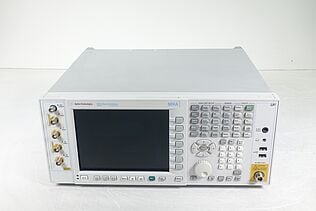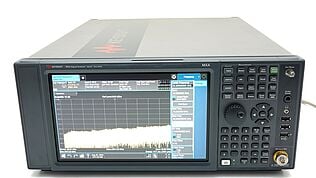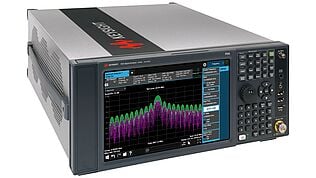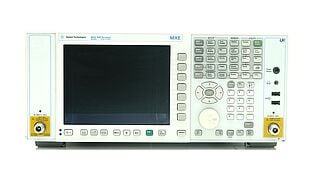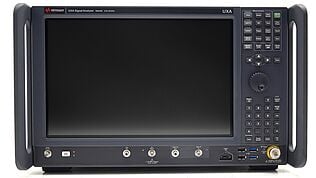- Introduction
- What is a Transformer?
- Practical Applications of Transformers
- Fundamental Electrical Principles Behind Transformers
- Empower Your Power Systems with Precision Tools
- Key Components of a Transformer
- Cores
- Windings
- How Do Transformers Work?
- Electromagnetic Induction
- Flux Linkage
- Types of Electrical Transformers
- Power Transformers
- Distribution Transformers
- Instrument Transformers
- Autotransformers
- Isolation Transformers
- Efficiency and Losses in Transformers
- Factors Influencing Transformer Efficiency
- Transformer Maintenance and Testing
- Transformer Safety and Troubleshooting
- Optimize Your Transformer Analysis with Keysight’s Premium Refurbished Equipment
- Whenever You’re Ready, Here Are 5 Ways We Can Help You
Think of a transformer as the translator of the electrical world. Just like a skilled translator converts one language to another while retaining the meaning, a transformer changes voltage levels to suit different applications without altering the electrical power.
You need this conversion to ensure that the power you’re working with matches the requirements of your equipment, whether you're boosting voltage for long-distance transmission or stepping it down for safe use in your devices.
These decisions directly impact efficiency and safety in your projects. So you might wonder, "Which type of transformer is the best fit for my application?" or "How can I minimize energy loss and improve reliability?"
Understanding transformers is crucial because they are at the heart of every power system, stepping voltage up or down to meet your needs.
By diving into the principles of electromagnetism and voltage conversion, you'll gain a clearer picture of how transformers operate and why they’re essential for modern electrical systems.
In this guide, you’ll explore the key concepts and components that make transformers work, helping you make informed decisions and optimize your power systems.
What is a Transformer?
A transformer is an electrical device that changes voltage levels to match the needs of different applications. Its primary function is to either step up (increase) or step down (decrease) voltage while maintaining the same power level.
Transformers operate using electromagnetic induction and mutual inductance. Alternating current in the primary winding generates a magnetic field, which induces a voltage in the secondary winding.
The ratio of the windings determines the voltage conversion. This process allows transformers to efficiently adjust voltage for safe and effective power distribution across various systems.
Practical Applications of Transformers
Transformers play a critical role in many industrial and commercial applications, ensuring efficient power management and distribution. Here's how they are used across different settings.
Power Distribution Networks
- High-voltage transmission: Transformers step up voltage for long-distance power transmission, reducing energy losses and allowing efficient transport over large distances.
- Voltage step-down: At substations, transformers step down high voltage to safer, usable levels for residential, commercial, and industrial consumers.
- End-user delivery: Distribution transformers further lower the voltage to levels appropriate for household appliances and small businesses, ensuring safe and reliable electricity supply.
Industrial Settings
- Manufacturing plants: Transformers provide the necessary voltage levels for various machinery and equipment, ensuring stable power supply for production lines and automation systems.
- Data centers: Transformers deliver precise voltage regulation to critical infrastructure, maintaining continuous and reliable power for servers and IT equipment, which is essential for data processing and storage.
Renewable Energy Integration
- Solar and wind farms: Transformers convert the variable output from renewable energy sources into stable, grid-compatible voltage, facilitating the integration of renewable energy into the power grid.
- Grid-tied inverters: Transformers in inverters step up the voltage from renewable energy systems to match grid requirements, ensuring smooth and efficient energy transfer to the main grid.
Specialized Applications
- Electric vehicles: Transformers in charging stations convert the grid voltage to suitable levels for charging EV batteries, supporting the growth of electric mobility.
- Smart grids: In smart grid systems, transformers enable dynamic voltage regulation and efficient power distribution, supporting advanced features like load balancing and real-time monitoring.
Transformers are indispensable in modern electrical systems, from basic power distribution to advanced applications like renewable energy and smart grids. Their ability to convert and regulate voltage ensures reliable power delivery across various domains, improving efficiency and supporting technological advancements.
Fundamental Electrical Principles Behind Transformers
Understanding transformers starts with some fundamental electrical concepts:
- Voltage: The electric potential difference between two points. In transformers, voltage is adjusted to match the needs of different applications.
- Current: The flow of electric charge through a conductor. The transformer's design ensures the current is compatible with the voltage level required.
- Resistance: The opposition to current flow in a material. Efficient transformer design minimizes resistance to reduce energy loss.
Electromagnetism and Faraday’s Law
Electromagnetism underpins transformer operation. According to Faraday’s Law, a changing magnetic field within a coil of wire induces an electromotive force (EMF).
In transformers, alternating current in the primary coil creates a changing magnetic field, inducing voltage in the secondary coil.
This principle allows transformers to adjust voltage levels by varying the number of turns in each coil, ensuring efficient voltage conversion to meet specific requirements.
Empower Your Power Systems with Precision Tools
Key Components of a Transformer
A transformer comprises several key components, each playing a crucial role in its operation. The primary components include the magnetic core and the windings, which work together to transfer energy between circuits through electromagnetic induction.
Cores
The magnetic core of a transformer is essential for directing the magnetic flux generated by the windings. It efficiently channels the magnetic field between the primary and secondary windings, improving the transformer's performance.
Common Core Materials
- Laminated silicon steel: Reduces energy loss due to eddy currents and is widely used for its efficiency.
- Ferrite: Used in high-frequency applications for its low electrical conductivity and high magnetic permeability.
Types of Cores
- Laminated core: Consists of stacked layers to reduce energy loss and is commonly used in power transformers.
- Toroidal core: A donut-shaped core that provides better magnetic coupling and reduced losses, ideal for compact transformers and lower electromagnetic interference.
- Ferrite core: Used in high-frequency applications due to its low eddy current losses.
Windings
The primary and secondary windings are coils of wire wrapped around the core. The primary winding receives the input voltage, creating a magnetic field, while the secondary winding converts this field into the desired output voltage.
Common Winding Materials
- Copper: Favored for its high conductivity and lower resistance, leading to reduced energy losses.
- Aluminum: Chosen for its cost-effectiveness and lighter weight, used in applications where weight and cost are critical factors.
Winding Configuration
- Number of turns: The ratio of turns between the primary and secondary windings determines the voltage transformation. More turns in the secondary winding compared to the primary will step up the voltage, while fewer turns will step it down.
- Winding arrangement: Ensures efficient magnetic coupling and optimal performance for the specific voltage requirements.
How Do Transformers Work?
A transformer functions by transferring electrical energy between two or more circuits through electromagnetic induction. This process involves the interaction of primary and secondary windings with a magnetic core, allowing the transformer to adjust voltage levels effectively.
Electromagnetic Induction
Electromagnetic induction is the cornerstone of transformer operation. Here’s how it works:
- Application of AC voltage: Alternating current is applied to the primary winding.
- Creation of magnetic field: The AC flowing through the primary winding generates a time-varying magnetic field around it.
- Magnetic flux in core: This magnetic field induces a magnetic flux in the core, which fluctuates with the AC.
- Induction in secondary winding: As the magnetic flux changes, it induces an electromotive force or voltage in the secondary winding according to Faraday’s Law of Induction.
- Voltage transformation: The induced voltage in the secondary winding depends on the ratio of turns between the primary and secondary windings, resulting in a stepped-up or stepped-down voltage.
Flux Linkage
Flux linkage describes the relationship between the magnetic flux generated in the core and the windings of the transformer.
- Magnetic path: The magnetic flux generated by the primary winding travels through the magnetic core.
- Linking windings: As the flux travels through the core, it links the primary and secondary windings, creating a magnetic field that affect them.
- Induction efficiency: Effective flux linkage ensures that the magnetic field generated by the primary winding induces a maximum possible voltage in the secondary winding. This linkage is crucial for efficient voltage transformation, as it minimizes energy losses and maximizes the power transferred from the primary to the secondary circuit.
By optimizing the design of the core and the windings to ensure effective flux linkage, transformers achieve high efficiency in voltage conversion. This efficient transfer of energy is essential for various applications, from power transmission to everyday electronics.
Types of Electrical Transformers
Transformers come in various types, each tailored for specific functions and applications. Understanding these types helps you select the right transformer for your needs, whether it's for power distribution, measurement, or safety.
Power Transformers
Power transformers are critical for high-voltage transmission networks, enabling efficient long-distance power transport. These transformers operate at high voltage levels (typically above 33 kV) and are designed to handle large power capacities.
Key Characteristics
- High power handling: Power transformers can manage substantial amounts of power, making them essential for transmission and distribution networks.
- Location: Typically found in power generation stations and large substations, where they step up the voltage for transmission or step it down for distribution.
- Efficiency: Designed for maximum efficiency at high loads, minimizing energy losses during transmission.
Distribution Transformers
Distribution transformers lower the voltage to levels suitable for residential and commercial use. These transformers are the last step in the electrical distribution chain, making electricity safe for everyday consumption.
Design Features
Size and efficiency: Smaller and more efficient at handling lower voltages (up to 33 kV) compared to power transformers.
Placement: Usually mounted on utility poles or placed in ground-level substations near end users.
Load adaptability: Designed to operate efficiently over a range of load conditions, including periods of low demand
Instrument Transformers
Instrument transformers include current transformers (CTs) and potential transformers (PTs), which are used for measurement and protection in power systems.
Definitions and Uses
- Current transformers: Measure high currents by producing a reduced current proportional to the current in the primary circuit. Commonly used in substations for protective relays and metering.
- Potential transformers: Provide a scaled-down voltage to instruments for safe measurement and monitoring. Essential for metering and monitoring high-voltage systems.
Autotransformers
Autotransformers differ from other transformers because they use a single winding that acts as both the primary and secondary winding. This design allows for voltage conversion with fewer windings.
Advantages and Limitations
- Cost and size: More compact and cost-effective than traditional transformers because they use less material.
- Limitations: Not suitable for applications requiring electrical isolation between the input and output circuits due to the shared winding.
Isolation Transformers
Isolation transformers are used to decouple circuits, providing electrical isolation to protect against electrical interference and improve safety.
Applications
- Safety: Commonly used in medical equipment to isolate sensitive devices from power surges and electrical noise.
- Protection: Used in sensitive electronic systems where interference from other devices can cause malfunctions.
Comparison Table of Transformer Types
| Type | Voltage Levels | Primary Use | Key Characteristics |
| Power Transformer | High voltage (>33 kV) | High-voltage transmission | Handles large power levels; high efficiency at high |
| Distribution Transformer | Low to medium voltage (up to 33 kV) | For residential, commercial use | Small size, high efficiency over varying load conditions |
| Instrument Transformer | Varies by type | Measurement, protection | Current (CT) and potential (PT) transformers for accurate measurement |
| Autotransformer | Varies by design | Voltage conversion with no isolation | Cost-effective, compact; shared winding |
| Isolation Transformer | Low to medium voltage | Circuit isolation | Provides electrical isolation; used in sensitive applications |
By understanding these types, you can choose the transformer that best fits your specific power needs, ensuring efficiency, reliability, and safety in your electrical systems.
Efficiency and Losses in Transformers
Transformer efficiency measures how effectively a transformer converts input power into output power, with minimal losses.
It’s defined as the ratio of the useful power output to the power input, typically expressed as a percentage.
High efficiency is crucial for reducing operational costs and improving the performance of electrical systems.
Factors Influencing Transformer Efficiency
Several factors influence transformer efficiency, including core and copper losses, as well as stray losses that can impact overall performance. Understanding and mitigating these losses is essential for optimizing transformer operation and achieving high efficiency.
Core Losses
These occur in the transformer’s magnetic core and are divided into two categories:
- Hysteresis losses: Caused by the repeated magnetization and demagnetization of the core material. These losses depend on the material’s magnetic properties and the frequency of the AC.
- Eddy current losses: Induced currents in the core’s conductive materials create heat, contributing to energy loss. These losses increase with the thickness of the core laminations and the square of the frequency.
Minimization Methods
- Hysteresis losses: Use materials with low hysteresis, such as high-grade silicon steel.
- Eddy current losses: Use thin, laminated core sheets to reduce the path for induced currents.
Copper Losses
Also known as I²R losses, copper losses occur due to the resistance in the transformer windings. As current flows through the windings, the resistance causes power dissipation in the form of heat.
Minimization Methods:
- Use high-conductivity materials like copper.
- Design windings with larger cross-sectional areas to reduce resistance.
Stray Losses
These losses arise from leakage flux that does not follow the intended magnetic path and instead induces currents in nearby conductive components.
Minimization Methods
- Design transformers with improved magnetic shielding.
- Optimize winding and core design to minimize leakage flux.
Types of Losses and Minimization Methods
| Type of Loss | Description | Minimization Methods |
| Hysteresis Losses | Energy lost in repeatedly magnetizing the core | Use low-hysteresis materials (e.g., silicon steel) |
| Currents induced in the core, creating heat | Use thin, laminated cores |
| Copper Losses | Heat generated by resistance in windings | Use high-conductivity materials (e.g., copper); increase winding cross-sectional area |
| Stray Losses | Induced currents in non-magnetic components | Improve magnetic shielding; optimize design |
Cooling Methods for Managing Losses
To maintain efficiency and prevent overheating, transformers employ various cooling methods.
- Oil cooling: Transformers are immersed in insulating oil, which dissipates heat away from the core and windings. The oil absorbs heat and transfers it to radiators or coolers. This method is effective for large transformers with significant heat generation.
- Air cooling: Smaller transformers often use air as a cooling medium. Forced air cooling involves blowing air over the transformer surfaces using fans, improving heat dissipation.
- Water cooling: Some high-power transformers use water cooling, where water circulates through heat exchangers to remove heat from the transformer oil or directly from the core and windings.
By using these cooling techniques and minimizing losses, transformers can achieve higher efficiency, reducing energy waste and extending their operational life. This ensures reliable performance across various applications, from power distribution to industrial processes.
Transformer Maintenance and Testing
Maintaining and testing transformers is crucial for ensuring their longevity and reliable operation. Routine maintenance tasks and modern testing methods help identify potential issues early, preventing costly failures and extending the transformer's service life.
Routine Maintenance Tasks
- Visual inspections: Regularly check for physical damage, oil leaks, and signs of overheating.
- Oil analysis: Test insulating oil for moisture, acidity, and dissolved gases to assess insulation condition and detect potential faults.
- Clean: Remove dirt and debris from cooling fins and external surfaces to maintain effective cooling.
- Tighten connections: Inspect and tighten electrical connections to prevent loose contacts that can cause overheating and failures.
Common Testing Methods
- Insulation Resistance Testing: Measures the insulation resistance between windings and ground to identify deterioration or contamination. Low insulation resistance indicates potential faults in the insulation.
- Transformer Turns Ratio (TTR) Testing: Verifies the ratio of primary to secondary windings to ensure it matches design specifications. Deviations can indicate issues like winding short-circuits or incorrect tap settings.
- Power Factor Testing: Assesses the condition of insulation by measuring the power factor (or dissipation factor). High power factor values can indicate insulation degradation.
Modern Monitoring Systems
Modern monitoring systems offer real-time insights into transformer health, enabling predictive maintenance and early fault detection.
These systems can track parameters such as temperature, moisture levels, and gas content in the insulating oil, providing data to predict potential failures before they occur. This approach minimizes downtime and maintenance costs by addressing issues proactively.

Signal Generators for Testing
Signal generators are valuable tools for transformer testing, allowing technicians to apply a known signal to the transformer and assess its response. This method helps verify performance characteristics and identify issues like winding defects or incorrect voltage ratios.
To improve your testing capabilities, consider using premium refurbished equipment from Keysight Technologies. Refurbished signal generators and other testing instruments from Keysight provide high-quality performance at a reduced cost, ensuring accurate and reliable transformer diagnostics without breaking your budget.
By combining routine maintenance, advanced testing methods, and modern monitoring systems, you can keep your transformers running efficiently, maximizing their operational lifespan and performance.
Transformer Safety and Troubleshooting
Ensuring safety and troubleshooting transformers are crucial to prevent accidents and maintain reliable operation. Implementing proper protocols, identifying common faults, and taking preventive measures are essential for effectively managing transformer issues.
Essential Safety Protocols
- De-energize equipment: Always disconnect and discharge transformers before maintenance or troubleshooting to prevent electric shock.
- Use protective gear: Wear appropriate personal protective equipment (PPE) such as gloves, safety glasses, and arc-rated clothing.
- Follow lockout/tagout procedures: Implement lockout/tagout protocols to ensure that the transformer cannot be accidentally energized while maintenance is ongoing.
- Maintain safe distances: Keep a safe distance from energized parts and follow established safety clearances to avoid electrical hazards.
Common Issues and Faults
- Overheating: Caused by excessive load or poor cooling, leading to insulation breakdown and transformer damage.
- Insulation failure: Results from aging, moisture, or contamination, leading to short circuits or arcing.
- Winding faults: Include open circuits, short circuits, or incorrect winding connections, affecting voltage regulation and transformer performance.
Troubleshooting Guide
- Visual inspection: Check for signs of physical damage, oil leaks, and discoloration on the transformer surface.
- Temperature check: Use infrared thermography or temperature sensors to detect overheating or hot spots.
- Insulation resistance test: Measure the insulation resistance to identify deterioration or contamination.
- Check connections: Inspect and tighten all electrical connections to ensure they are secure and properly configured.
- Test windings: Use a multimeter to measure winding resistance and check for open or short circuits.
Preventive Measures
- Regular maintenance: Conduct routine inspections and maintenance to address potential issues before they escalate.
- Load management: Ensure the transformer operates within its rated capacity to prevent overheating and overloading.
- Proper cooling: Maintain adequate cooling systems, such as oil or air cooling, to manage temperature effectively.
- Moisture control: Use desiccants or sealed environments to keep moisture out of the transformer, preserving insulation integrity.
Using Multimeters for Diagnosis
Multimeters are essential tools for diagnosing transformer issues. They provide precise measurements to identify:
- Open circuits: Detect breaks in the winding or connections.
- Short circuits: Identify unintended connections causing current leakage or faults.
- Incorrect winding connections: Verify correct winding configurations and continuity.
For accurate diagnostics and reliable results, consider using premium refurbished multimeters from Keysight Technologies. Keysight’s refurbished equipment offers high performance and precision at a fraction of the cost of new instruments, making them a smart choice for effective transformer troubleshooting.
By adhering to safety protocols, implementing preventive measures, and using reliable diagnostic tools, you can improve transformer safety and resolve common issues efficiently, ensuring sustained transformer performance and reliability.
Optimize Your Transformer Analysis with Keysight’s Premium Refurbished Equipment
Transformers are vital for managing voltage levels across various applications, from power distribution and industrial systems to renewable energy integration and specialized uses like electric vehicles.
Ensuring their efficiency, reliability, and longevity requires thorough maintenance, accurate testing, and proactive troubleshooting. Addressing issues like overheating, insulation failure, and winding faults can be challenging, but with the right tools, these tasks become manageable and efficient.
At Keysight Technologies, we understand the common concerns engineers face when analyzing and maintaining transformers—whether it’s ensuring precise diagnostics, minimizing downtime, or managing costs.
Our premium refurbished equipment, including multimeters and signal generators, offers the high performance and accuracy you need without breaking your budget.
By choosing Keysight’s refurbished products, you gain access to top-tier testing capabilities at a fraction of the cost, making it easier to achieve reliable, accurate results.
Trust in Keysight to provide the tools that empower you to maintain and optimize your transformers, ensuring they meet the demands of modern electrical systems while keeping costs under control.

Whenever You’re Ready, Here Are 5 Ways We Can Help You
- Browse our premium used network analyzers, oscilloscopes, signal analyzers and waveform generators.
- Call tech support US: 1 800 829-4444
Press #, then 2. Hours: 7am – 5pm MT, Mon– Fri - Talk to our sales support team by clicking the icon (bottom right corner) on every offer page
- Create an account to get price alerts and access to exclusive waitlists.
- Talk to your account manager about your specific needs





















